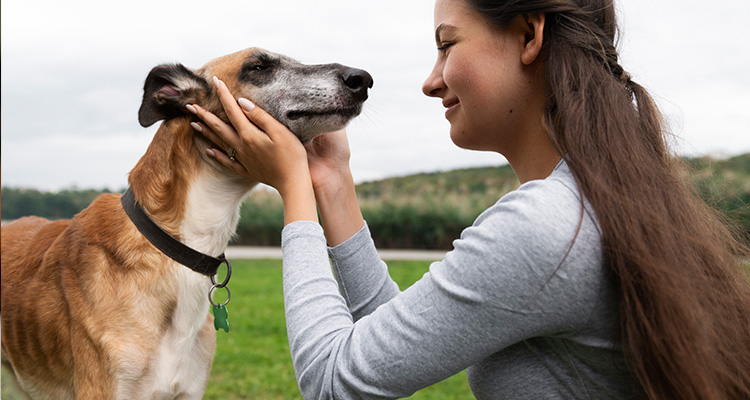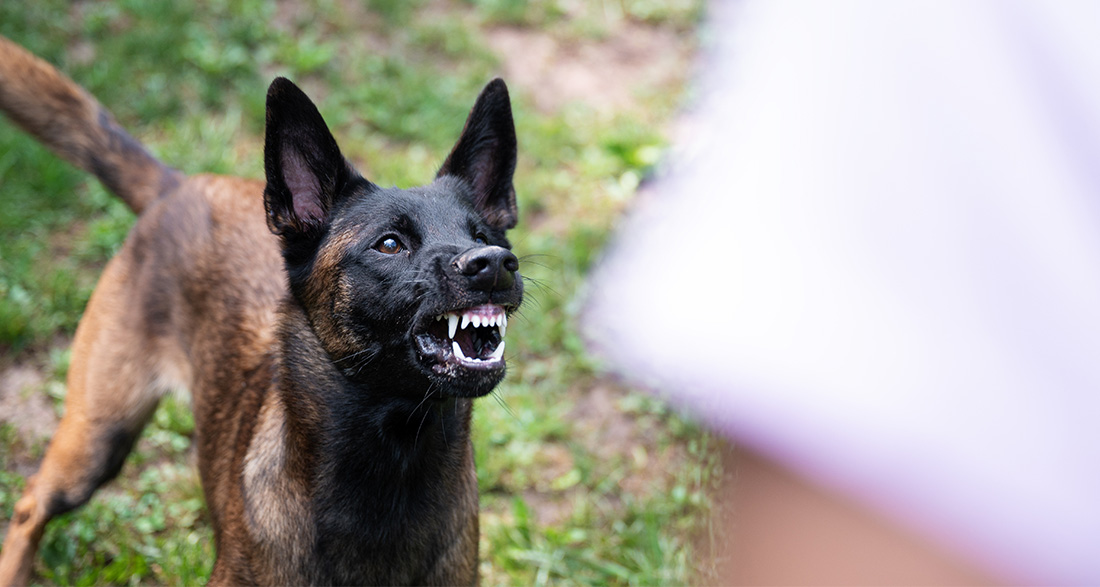When a dog behaves aggressively, as owners, we can quickly feel overwhelmed. Here you’ll learn the best ways to handle an aggressive dog and how to work on his behavior.
First and foremost: A dog is never inherently aggressive or malicious. An aggressive dog behaves this way because he has the need to defend himself. It’s a survival instinct in your dog. However, such behavior should never be taken lightly. Instead, it’s crucial to identify the reasons behind the dog’s aggressive behavior and then work on it seriously, preferably with professional assistance.
Why is my dog aggressive?
If a dog feels uncomfortable or fearful in a particular situation, he may respond aggressively. For the dog, this is the last resort to make himself heard, so the situation, which he finds unbearable, can improve.
Aggressive behavior is, therefore, part of a dog’s natural behavioral repertoire. The problem arises when the dog is more dominant than other pack members or his owner, as the animal cannot be limited or disciplined. Other dogs or even people may get harmed.
Factors promoting aggressive behavior in dogs can include:
- Insufficient socialization: Inadequate or disrupted early training of the dog by other dogs or humans.
- Lack of training: Absence or inappropriate training methods and unclear and inconsistent behaviors from the human perspective.
- Traumatic experiences
- Chronic pain: An illness can permanently burden your dog and significantly influence his behavior, even making him aggressive.
- Intentional provocation by the owner
- Fear: The dog perceives a situation as potentially threatening.
- Misguided hunting instinct: Some dogs strongly react to motion stimuli that trigger their hunting instinct. Joggers or cyclists can become “prey.”
- Neurological disorders: Pathological changes in the brain can also trigger aggression.
In conclusion, it is usually the owner’s misbehavior that leads to the dog behaving aggressively. However, few dog owners intentionally put their dogs in situations where they react aggressively. More often, it is the ignorance and uncertainty of the owners that lead the dog to exhibit aggressive behavior.
What can I do if my dog is aggressive?

In most cases, dogs give warning signs before displaying overtly aggressive behavior. It is crucial here to observe carefully and defuse the situation for your dog before it can escalate. The goal is to make your dog feel safe again and not expose him to further stress. Generally, dogs bite only when, from their perspective, it is the last resort because all their warning signs and threats have been ignored.
Recognize warning signs from the dog
Pay close attention to your dog so that you can identify early when he feels uncomfortable, threatened, or frightened. Unconditionally free your dog from such a situation so that he does not resort to aggressive behavior, snapping, or barking.
Look out for the following signs in the dog’s body language:
- Yawning or licking over the muzzle: If the dog noticeably yawns or repeatedly licks over its lips, he indicates discomfort. Even when dogs turn their heads away, it means they find a situation unpleasant and want to appease their counterpart.
- Crouching and baring teeth: If your dog crouches, tucks his tail between his legs, raises his lips, so the nose ridge wrinkles, and shows his teeth, it’s a clear signal that he is afraid.
- Freezing and standing still: If the dog stiffens, his fur stands on end, and he becomes completely still, almost as if frozen, this is also a clear sign that he feels uncomfortable and may be on the verge of turning aggressive.
- Growling: Growling is a natural behavior for a dog, signaling that he feels uncomfortable or anxious and wants to get out of the situation. Please do not ignore this clear warning signal.
If you overlook your dog’s warning signals, and he learns that aggressive behavior, such as snapping, leads to success and relaxes the situation for him, he will likely resort to this behavior in the next stressful situation.
However, it is not his task but yours to watch over him and help when he feels uncomfortable!
How to Properly Handle Aggressive Dogs
First, the good news: Since a dog’s aggressive behavior can be significantly influenced by humans, as a dog owner, you can ensure that your dog sheds his aggressive behavior through the right training and behavior.
Start by carefully observing the situations in which your dog reacts aggressively, growls, or bares his teeth.
- Is he near other dogs, possibly for self-defense?
- Is he trying to protect family members or defending his food or toys against competitors?
Never reinforce your dog’s aggressive behavior by calming him with a gentle “It’s okay” in the situation. Dogs clearly understand their owner’s tone, and your reassurance could be misunderstood as praise.
Instead, firmly and calmly interrupt his behavior without becoming aggressive yourself. Stay as calm and confident as possible because only when your dog perceives you as a competent partner who accurately assesses and defuses threatening situations will he rely on you and not feel compelled to resolve situations through aggressive behavior.
Dogs have a keen sense of their owner’s well-being. Always keep in mind that your own insecurity transfers to your dog.
Training with an Aggressive Dog

Once you’ve identified the situations that make your dog aggressive, avoid them as much as possible. Ensure that basic obedience works smoothly before gradually training a different behavior in stressful situations.
Seek expert help, especially if situations recur and become uncontrollable for you as an owner, or if you feel threatened by your dog. Dog trainers, canine psychologists, and specialized behavior trainers for problem dogs can assist you and your dog in finding a common path away from his aggressive behavior. Seeking help is not something to be ashamed of; it’s a sign of courage and strength to address and resolve challenging situations.
What to Do If a Dog Is Aggressive Towards People
If your dog is aggressive towards other people during walks, always keep it on a leash and only in your immediate vicinity. Consider whether your dog should wear a muzzle. However, you should have trained your dog to wear a muzzle beforehand. If you have a garden, try to provide your dog with a lot of activity and mental stimulation in the safe environment of the garden, such as through scent games or dummy training.
If your dog behaves aggressively towards visitors in your home, separate the visitor and your dog spatially and seek professional help to address the problem.
If you are attacked by an aggressive dog, do not run away, as this triggers the dog’s hunting instinct. Stay as calm as possible, stand sideways to it, and avoid eye contact with the aggressive dog. Avoid making frantic or surprising movements. If the dog still tries to bite, try to present it with a substitute object like your backpack, so he hits the object and not you.
Aggressive Dog Endangers Other Dogs
Leash aggression and aggression towards other dogs can be common. If you have a dog prone to aggressive behavior towards other dogs and it is not reliably recallable, always keep him on a leash. If you encounter another dog while walking, make sure to maintain a sufficient distance from the other human-dog team so that your dog does not feel pressured or threatened by his counterpart and is not tempted to bark. If the other dog is off-leash, ask the owner to leash their dog.
If a fight breaks out between dogs, do not try to separate them with your hands, as there is a risk that the dogs may redirect their aggression towards you and accidentally bite you. Dog fights, especially among males, often sound worse than they are. Try to distract the animals by making surprising loud noises, throwing your jacket on them, or pouring water on them. This element of surprise can help the dogs withdraw from the fight.


